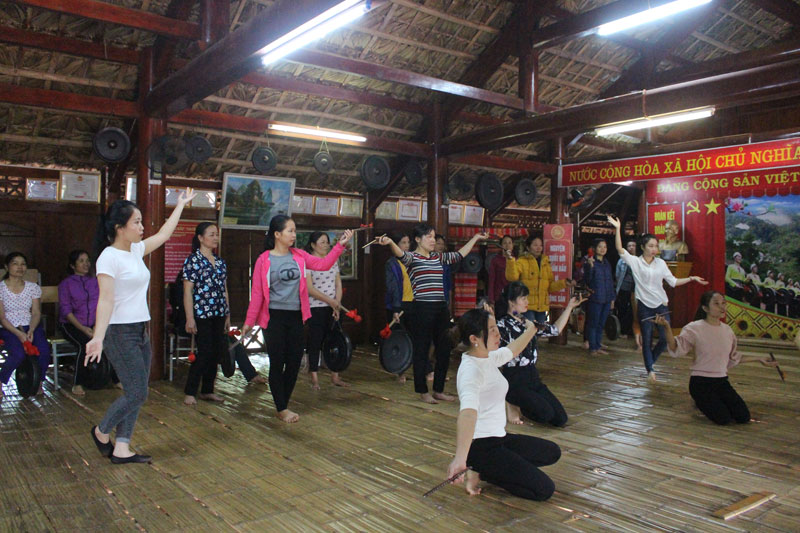
(HBO) - With the continuous achievements in the top of the district at the festivals and mass performances, Phong Phu commune (Tan Lac) has affirmed that the movement of mass performance has a strong vitality, it is not only a rich spiritual dish of the local people, but it also contributes to conserving, preserving and developing the national culture.
 The performance group of the Phong Phu Commune (Tan Lac) often practices to have good performances to serve the local people and tourists.
The performance group of the Phong Phu Commune (Tan Lac) often practices to have good performances to serve the local people and tourists.
The movement of mass performance in Phong Phu commune has been flourishing. The members of the entertainment teams are not only middle-aged and the elderly people, but the teenagers has been joining more and more.
A special feature and vitality of the movement of mass performance in Phong Phu is the passion and the enthusiasm of the amateur artisans and actors for conserving and preserving the traditional cultural values of the people, the enthusiastic reception and encouragement of the People through the shows. In addition to practicing and performing, the team members have also actively guided and taught folk songs, gongs ... to their children, the small children in the neighborhood, and the people who are passionate about the traditional culture of the nation. Thereby, it not only helps the art teams have the opportunity to perform, exchange and learn more experiences, but it also contributes to conserving, preserving and promoting the national cultural identity. Every year, on the occasions of festivals, New Year or anniversaries, the commune organizes the cultural and arts exchanges with the participation of the commune’s art teams. On these occasions, the art teams have invested, prepared and practiced to bring the best performances to the local people.
The attraction of the mass performance is increasingly being affirmed, becoming an indispensable spiritual dish of the People in the localities. As a result, the people are more aware of their role in building the cultural life at the grassroots, creating a driving force for the movement of production emulation, tightening national the solidarity, contributing to conserving, preserving and promoting the traditional art forms of the nation.
Gongs hold a special place in the cultural and spiritual life of the Muong ethnic people in Hoa Binh province. More than musical instruments, they are an indispensable part of community rituals and collective memory, echoing through generations as a spiritual thread linking the past, present, and future.
Preserving and promoting the cultural values of the Muong ethnic group has become an urgent task in the current context, as many traditional values face the risk of fading away. This effort requires not only protecting the cultural identity but also eliminating outdated customs and developing a modern cultural lifestyle, contributing to sustainable values for the Muong community in Hoa Binh province.
The Muong ethnic culture, deeply rooted in Vietnam’s mountainous north, continues to be preserved and revitalised by dedicated individuals and communities determined to safeguard their ancestral identity.
The Muong group is one of the largest ethnic minorities in Vietnam, primarily found in Hoa Binh province. The Muong people in Hoa Binh boast a rich and diverse cultural treasure that reflects the unique identity of this ethnic group. Accounting for over 63% of the province's population, they have created and preserved numerous distinctive cultural values, contributing to their unique identity. Their cultural heritage is an invaluable asset, at the heart of their national identity, and represents a vibrant spiritual life that must be preserved and promoted in today’s modern world.
For generations, the ethnic communities of Hoa Binh province, particularly the Muong people, have preserved vibrant festivals deeply intertwined with the region’s geography, nature, and social traditions. These celebrations enrich Hoa Binh’s spiritual life and cultural identity, reflecting both folk beliefs and the intermingling of ethnic customs. Many of these festivals have endured the test of time, passed down through generations and continuing to thrive today. Among them, the Khai Ha (Going Down to the Field) festival stands out as one of the most significant events of the Muong ethnic group.
Muong calendar, known as sach doi, is an ancient folk knowledge system developed through observations of the movement of the pleiades star. This unique calendar consists of 12 bamboo sticks, each representing a lunar month. Specific days within each month are marked with distinct symbols, guiding locals in determining auspicious and inauspicious days for important activities.



 The performance group of the Phong Phu Commune (Tan Lac) often practices to have good performances to serve the local people and tourists.
The performance group of the Phong Phu Commune (Tan Lac) often practices to have good performances to serve the local people and tourists.